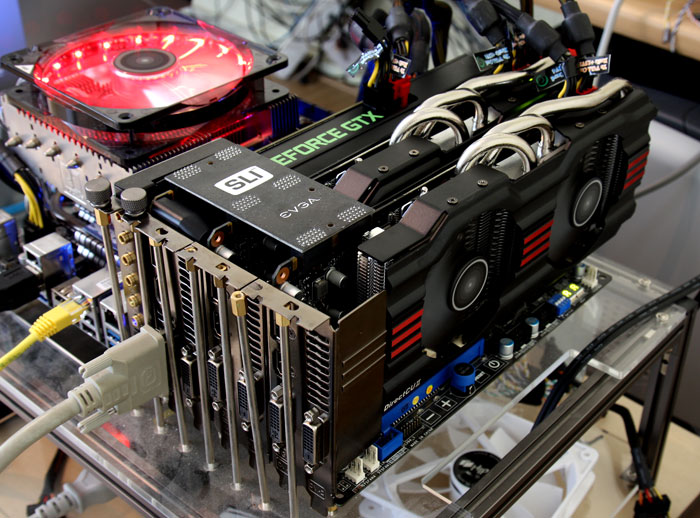Final Words & Conclusion
Final Words & Conclusion
Right then, conclusion time. First off, NVIDIA might have shot themselves in the foot. I mean why buy GeForce GTX 680 if GeForce GTX 670 is so darn close in terms of overall performance? If anything SLI with its offsets here and there drives the graphics cards even closer to each other when it comes to peak game performance. You better save yourself some money my friends.
Now we started this review with single monitor gaming in mind. The reality is that with graphics cards in this performance bracket only 2-way SLI is a viable solution unless you really use the hottest games that are extremely GPU dependant. Once you reach a monitor resolution of 2560x1440 or 2560x1600 that's where a third card starts to make a difference, albeit slowly.
Our recommendation is that with a single monitor setup like 1920x1080/1200 your maximum number of GTX 670 cards set up in SLI should be two. As you have seen 2-way SLI scaling is pretty darn impressive, pretty much similar to one GTX 690. Now, if you have that nice 30" monitor with a 2560x1440 or 2560x1600 resolution, that's where that 3rd card can matter. But in my opinion not enough.
Obviously there's something else to consider, it's multi monitor gaming. If you're going to be using 3 monitors at 5760x1080 (6MPixels) that's where a 3rd card would make some sense but even so, at 2560x1600 (4Mpixels) we're using only a third less in pixels to render.

So performance wise, up-to 2-way very little negative can be said about the GeForce GTX 670 set up in SLI. Bare in mind that a second or third card in gaming under stress does make the setup a good notch louder, do keep that in mind if you are a little 'icky' about noise levels. What also needs to be said its that the noise levels are subject to the model and brand you choose of course. The DirectCU II cards are quite silent, the reference cards so close to each other produce way more noise.
Power consumption then, two GPUs consume roughly 300 Watts whilst three GPUs use roughly 450W, add to that the rest of your system (processor, chipset peripherals) at say 200 Watts and you'll find yourself in the 650~700 Watt power consumption region when playing a hefty game. If you plan to overclock CPU and GPUs, then make sure you add another 200W onto your PSU requirements. Our recommendation really is to go with an 800~900 Watt power supply if you plan to go with 3 GeForce GTX 670 cards and a beefy system. Overclocking equals increased voltages equals increased power consumption equals much more load on the PSU.
Bare in mind that to be able to operate two or more cards in SLI mode you'll need a SLI compatible motherboard, most if not all Intel X58, P67, Z68, H77, Z77 and X79 motherboards are SLI certified, some P55 motherboards as well. AMD's 900 series carry SLI support as well. Carefully make sure and check that out before opting for your SLI preference and thus before purchasing multiple cards.
So let me wrap it up, three GTX 670 cards set up in SLI will still cost you say 1150 EUR alone, for that money you'll gain a truckload of performance kicking your configuration into the highest gear performance wise. We'll admit it though, if you are on a single monitor, there's just no point purchasing it unless you like to break 3DMark scores.
However, if you are gaming on a nice 30" monitor or are planning a multi-monitor setup for 3-way SLI, only there this setup starts to make sense. And that makes 3-way SLI with the GTX 670s only something to consider for the ones that plan to go awfully extreme. But that's never been any different of course. Our recommendation, on a single monitor two cards will benefit you the best when you look at multi-GPU scaling, after two cards things get increasingly difficult to justify. But 2-way SLI we can surely recommend.
Our recommendation, on a single monitor two cards will benefit you the best when you look at multi-GPU scaling, after two cards things get increasingly difficult to justify. But 2-way SLI we can surely recommend.
Allow me to divert from SLI for a second, the ASUS GeForce GTX 670 DirectCU II graphics cards kick ass, they are not at all noisy (Depeche Mode Enjoy the Silence came to mind here), have gangster looks, come factory overclocked and all customized. Again, we'll look at the card in a separate review as we like to go a little deeper with it.
We do hope you enjoyed this little mixture of multi-GPU lovin. Hilbert out...
- Leave/read comments on this product
- Sign up to receive an email when we publish new articles
- Or go back to Guru3D's front page.
